Power Electronics Market Size 2025-2029
The power electronics market size is valued to increase USD 11.14 billion, at a CAGR of 5.9% from 2024 to 2029. Increased adoption of renewable energy will drive the power electronics market.
Major Market Trends & Insights
- APAC dominated the market and accounted for a 55% growth during the forecast period.
- By Product - Discrete segment was valued at USD 21.2 billion in 2023
- By Material - Silicon segment accounted for the largest market revenue share in 2023
Market Size & Forecast
- Market Opportunities: USD 61.80 million
- Market Future Opportunities: USD 11143.90 million
- CAGR from 2024 to 2029 : 5.9%
Market Summary
- The market is experiencing significant growth, driven by the increasing adoption of renewable energy sources and the rise in implementation of smart grids. According to a recent report, The market was valued at USD120.5 billion in 2020 and is projected to reach USD181.5 billion by 2026, growing at a steady rate of 6.5% per annum. This expansion is fueled by the need for efficient energy conversion and management in various industries, including transportation, industrial, consumer electronics, and renewable energy. Despite this progress, challenges persist, particularly in the realm of power electronics components.
- For instance, the technological limitations of metal-oxide-semiconductor field-effect transistors (MOSFETs) continue to hinder their widespread adoption. Efforts are underway to address these challenges through advancements in wide bandgap semiconductors, such as gallium nitride (GaN) and silicon carbide (SiC), which offer improved power handling capabilities and efficiency. As the market evolves, it is essential for businesses to stay informed about the latest trends and developments. This includes the increasing integration of power electronics in renewable energy systems, the growing popularity of smart grids, and the ongoing research and innovation in power semiconductor technology. By staying abreast of these advancements, businesses can capitalize on the opportunities presented by this dynamic and ever-evolving market.
What will be the Size of the Power Electronics Market during the forecast period?
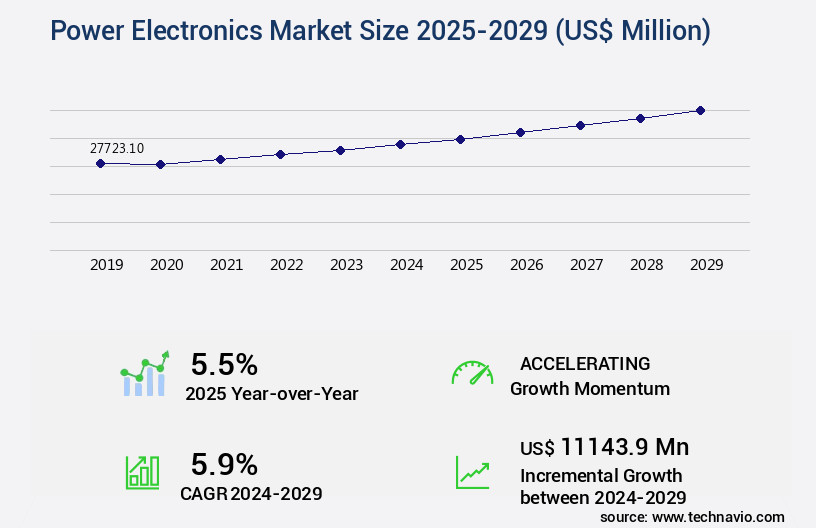
Get Key Insights on Market Forecast (PDF) Request Free Sample
How is the Power Electronics Market Segmented ?
The power electronics industry research report provides comprehensive data (region-wise segment analysis), with forecasts and estimates in "USD million" for the period 2025-2029, as well as historical data from 2019-2023 for the following segments.
- Product
- Material
- Silicon
- Silicon carbide
- Gallium nitride
- End-user
- Consumer electronics
- Industrial
- Automotive
- Biomedical and healthcare
- Others
- Geography
- North America
- Europe
- APAC
- China
- India
- Japan
- South Korea
- Rest of World (ROW)
By Product Insights
The discrete segment is estimated to witness significant growth during the forecast period.
The market continues to evolve, driven by the increasing demand for energy-efficient technologies and the integration of renewable energy sources. Power electronic systems, including ac-dc converters, dc-dc converters, and inverter technology, are at the heart of this transformation. These systems utilize advanced components such as power semiconductors, like insulated gate bipolar transistors (IGBTs) and metal-oxide-semiconductor field-effect transistors (MOSFETs), and high-frequency converters. Thermal management, through heat sinks and cooling systems, is crucial for maintaining power system stability. Key applications include motor drive systems, battery management systems, and electric vehicle chargers. Renewable energy integration necessitates power converters to ensure power quality and meet energy efficiency standards.
Advanced control methods, such as analog power control, digital power control, and soft switching techniques, are employed to optimize power density and improve power factor correction. Harmonic and RFI suppression are essential for maintaining power quality. The market for power electronic components, like resonant converters, IGBT modules, and thyristor control, is projected to reach USD130.5 billion by 2028, growing at a CAGR of 11.2% from 2021 to 2028. This growth is attributed to the increasing demand for power electronic systems in various industries, including transportation, industrial, and consumer electronics. By procuring modules instead of discrete components, engineers can save time and resources, reducing time-to-market.
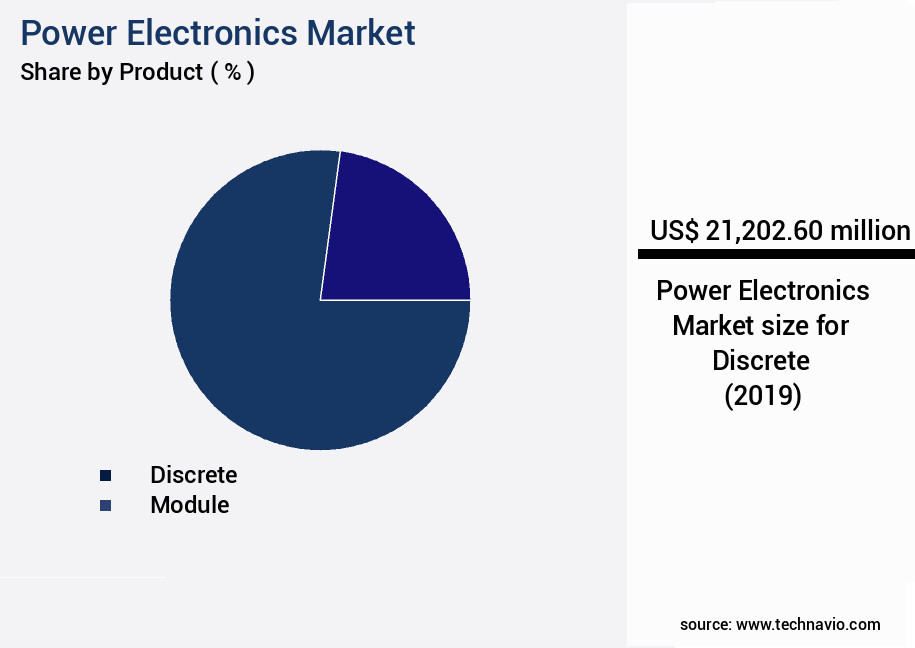
Request Free Sample
The Discrete segment was valued at USD 21.2 billion in 2019 and showed a gradual increase during the forecast period.
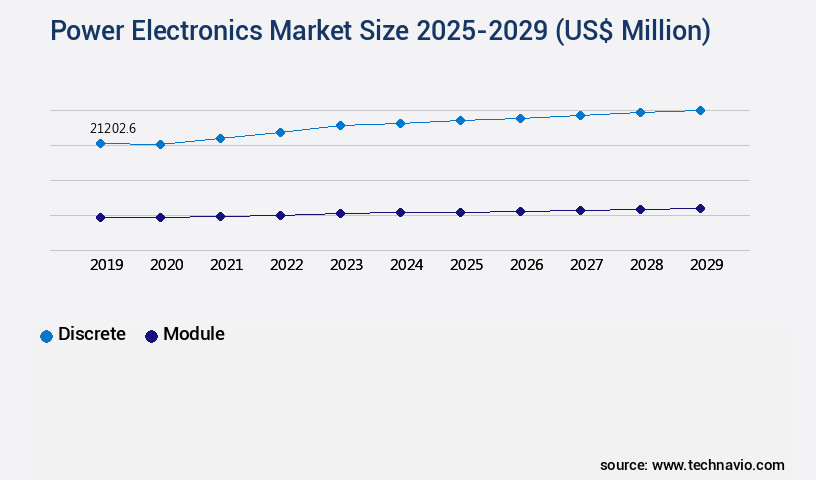
Request Free Sample
Regional Analysis
APAC is estimated to contribute 55% to the growth of the global market during the forecast period.Technavio's analysts have elaborately explained the regional trends and drivers that shape the market during the forecast period.
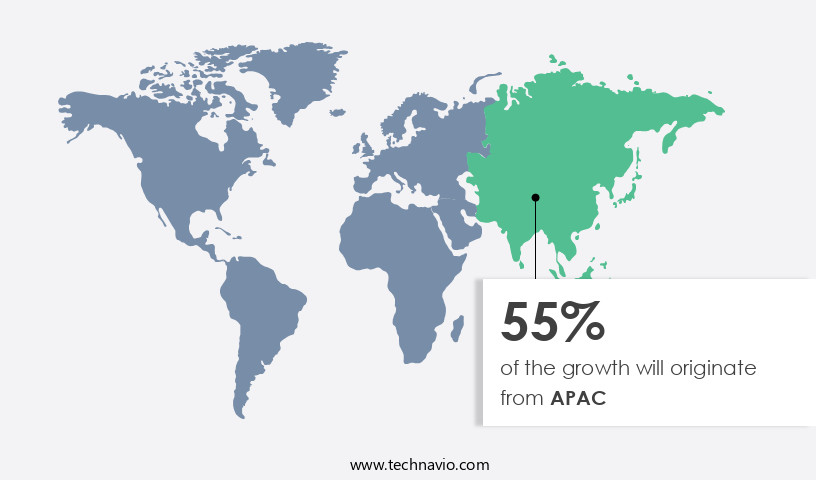
See How Power Electronics Market Demand is Rising in APAC Request Free Sample
The market in APAC is experiencing significant growth due to the increasing energy demand in developing nations within the region. By 2026, energy consumption is projected to rise by 50% compared to the levels recorded five years prior. Renewable energy sources are set to meet a substantial portion of this demand, as countries in APAC continue to prioritize sustainable energy targets. Japan, China, South Korea, and India are the primary contributors to the revenues generated in the regional the market.
Japan, South Korea, and Hong Kong lead the way in research expenditures. Government initiatives, particularly manufacturing-focused policies in China and India, are propelling the growth of the market in APAC.
Market Dynamics
Our researchers analyzed the data with 2024 as the base year, along with the key drivers, trends, and challenges. A holistic analysis of drivers will help companies refine their marketing strategies to gain a competitive advantage.
The market is experiencing significant growth due to the increasing demand for high-efficiency energy conversion and management solutions. One of the key trends driving this growth is the adoption of high-frequency resonant converter designs, which offer improved power factor correction and harmonic mitigation in power systems. These converters are increasingly being used in applications such as electric vehicles and renewable energy systems, where efficient charging and grid integration are crucial. Advanced power converter control strategies, including optimal control for DC-DC converters and improved power factor correction techniques, are also gaining popularity in the market. Wide bandgap semiconductor technology, such as silicon carbide MOSFETs and gallium nitride power transistors, is revolutionizing the industry with their ability to handle high voltages and temperatures, leading to high-power density converter designs and power loss minimization techniques. In the electric vehicle sector, efficient charging systems are essential to ensure long range and fast charging times. Advanced power semiconductor devices and thermal management solutions are key components in achieving this goal. Renewable energy grid integration poses challenges due to the intermittent nature of these sources, and power electronic packaging optimization and advanced power system protection are necessary to ensure reliability and power quality improvement. Furthermore, EMI reduction techniques in power converters are becoming increasingly important to minimize electromagnetic interference and ensure compatibility with other electronic systems. Fault diagnosis for power electronic systems and power system reliability enhancement are also critical to maintaining the stability and efficiency of power electronics applications. Overall, the market is continuously evolving to meet the demands of various industries and applications, with a focus on high-performance, efficient, and reliable power conversion and management solutions.
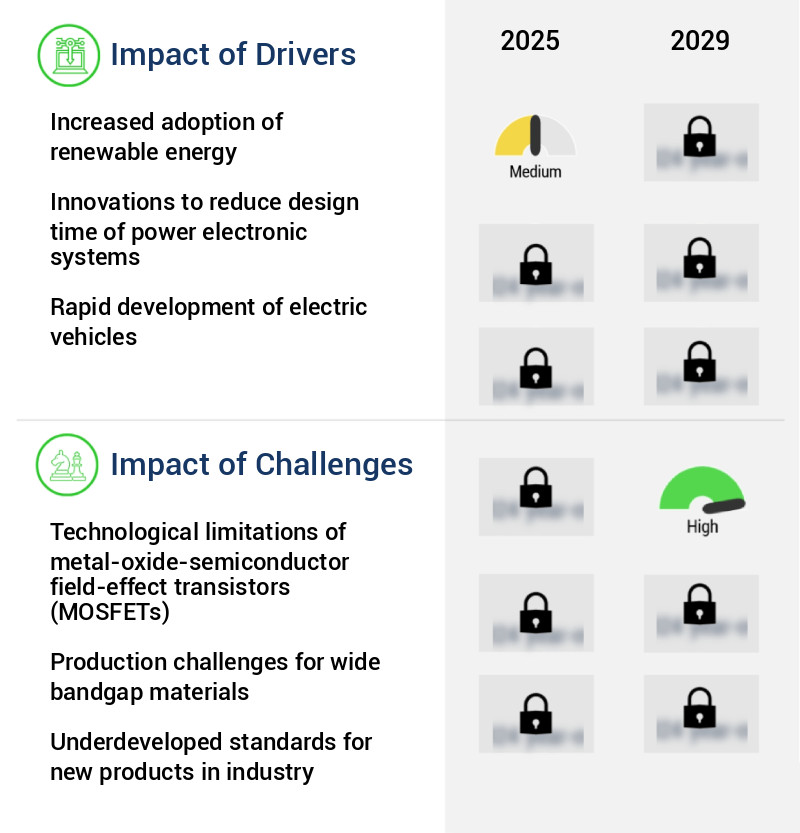
What are the key market drivers leading to the rise in the adoption of Power Electronics Industry?
- The significant expansion of renewable energy adoption serves as the primary market catalyst.
- The market is experiencing significant growth and diversification, driven by the increasing adoption of renewable energy sources and advancements in technology. For instance, the US Department of Energy's Renewable Energy Growth Program, which aims to produce 40 megawatts (MW) of renewable energy annually until 2029, presents substantial opportunities for market participants. This initiative encompasses solar, wind, hydropower, and anaerobic digestion projects, categorized as small, medium, or large based on power output. Institutions, including commercial, government, non-profit entities, can join this program and receive incentives to meet their respective power production targets.
- Consequently, The market benefits, with manufacturers supplying essential equipment to program participants. This trend underscores the evolving nature of the market and its pivotal role in supporting the transition towards renewable energy.
What are the market trends shaping the Power Electronics Industry?
- The adoption of smart grids is gaining momentum as the next market trend. Smart grids, which utilize advanced technologies for efficient energy management, are increasingly being adopted by utilities and consumers alike.
- Smart grids represent the evolution of power networks, integrating communication capabilities to enhance operability and efficiency. Countries like the US, Germany, Japan, and the European Union are investing in renewable energy resources, leveraging smart grids for improved power management. A smart grid encompasses all assets within a power network, including generation, transmission, distribution, and consumption. One significant feature is its capacity to generate substantial data volumes. The integration of automation devices, sensors, and other smart devices expands opportunities for utilities to handle multiple databases and synchronize them effectively.
- The market plays a crucial role in this transformation, providing components for efficient energy conversion and management. With the increasing adoption of renewable energy sources and smart grids, the market is poised for robust growth.
What challenges does the Power Electronics Industry face during its growth?
- The advancement of the semiconductor industry faces significant limitations due to the technological constraints of metal-oxide-semiconductor field-effect transistors (MOSFETs). These constraints pose a substantial challenge to industry growth.
- Power electronics, a critical segment of the electronics industry, is characterized by its extensive application in various sectors, including industrial, automotive, renewable energy, and consumer electronics. Power semiconductor devices, primarily based on silicon wafers, are the cornerstone of power electronics. IGBTs (Insulated Gate Bipolar Transistors), power MOSFETs (Metal-Oxide-Semiconductor Field-Effect Transistors), and super-junction power MOSFETs are among the most commonly used devices. IGBTs, with their configuration, are suitable for high-voltage applications exceeding 400V, while power MOSFETs cater to applications below 500V.
- Super-junction power MOSFETs operate in the voltage range between 500 and 900V. At higher voltages, IGBTs exhibit slower switching times, and super-junction power MOSFETs incur higher losses. To address the efficiency challenges in applications requiring operations in kilovolts, materials like wide bandgap and ultra-wide bandgap materials are being adopted. These materials help reduce losses at higher voltages, thereby enhancing the overall performance of power electronics systems.
Exclusive Technavio Analysis on Customer Landscape
The power electronics market forecasting report includes the adoption lifecycle of the market, covering from the innovator's stage to the laggard's stage. It focuses on adoption rates in different regions based on penetration. Furthermore, the power electronics market report also includes key purchase criteria and drivers of price sensitivity to help companies evaluate and develop their market growth analysis strategies.
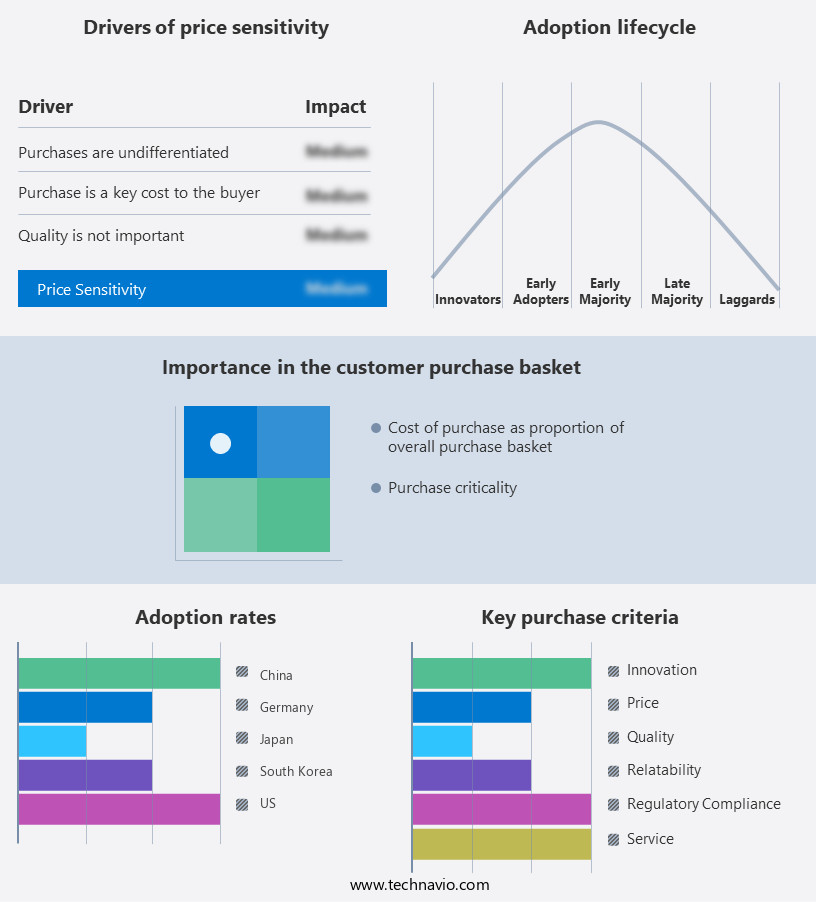
Customer Landscape of Power Electronics Industry
Competitive Landscape
Companies are implementing various strategies, such as strategic alliances, power electronics market forecast, partnerships, mergers and acquisitions, geographical expansion, and product/service launches, to enhance their presence in the industry.
ABB Ltd. - This company specializes in power electronics technology, providing converters, inverters, and drives for various industries, including automation and power grids, as well as electric mobility solutions. Their product offerings cater to diverse applications, enhancing efficiency and reliability.
The industry research and growth report includes detailed analyses of the competitive landscape of the market and information about key companies, including:
- ABB Ltd.
- Analog Devices Inc.
- Arete and Cocchi Technology
- Danfoss AS
- Fuji Electric Co. Ltd.
- General Electric Co.
- Infineon Technologies AG
- Magna Power Electronics Inc.
- Mitsubishi Electric Corp.
- NXP Semiconductors NV
- ON Semiconductor Corp.
- Power Electronics
- Renesas Electronics Corp.
- Schneider Electric SE
- STMicroelectronics NV
- Texas Instruments Inc.
- Toshiba Corp.
Qualitative and quantitative analysis of companies has been conducted to help clients understand the wider business environment as well as the strengths and weaknesses of key industry players. Data is qualitatively analyzed to categorize companies as pure play, category-focused, industry-focused, and diversified; it is quantitatively analyzed to categorize companies as dominant, leading, strong, tentative, and weak.
Recent Development and News in Power Electronics Market
- In January 2024, Infineon Technologies AG, a leading player in power electronics, announced the launch of its new 1200V IGBT650F3 power semiconductor, aiming to enhance efficiency and reduce system costs in various industrial applications (Infineon Technologies AG, 2024).
- In March 2024, Texas Instruments Inc. And ON Semiconductor Corporation entered into a strategic collaboration to develop and manufacture power management and power conversion solutions, combining their expertise and resources to cater to the growing demand for power electronics in the automotive and industrial sectors (Texas Instruments Inc., 2024).
- In May 2024, Vicor Corporation raised USD200 million in a senior secured term loan facility to support the growth of its power components business, including the expansion of its manufacturing capabilities and the development of new technologies (Vicor Corporation, 2024).
- In February 2025, the European Union passed the new Regulation on Energy Union and Climate Action, which includes provisions to promote the adoption of power electronics in various sectors, such as renewable energy, transportation, and Energy storage, to reduce greenhouse gas emissions and improve energy efficiency (European Parliament and Council of the European Union, 2025).
Dive into Technavio's robust research methodology, blending expert interviews, extensive data synthesis, and validated models for unparalleled Power Electronics Market insights. See full methodology.
|
Market Scope
|
|
Report Coverage
|
Details
|
|
Page number
|
230
|
|
Base year
|
2024
|
|
Historic period
|
2019-2023 |
|
Forecast period
|
2025-2029
|
|
Growth momentum & CAGR
|
Accelerate at a CAGR of 5.9%
|
|
Market growth 2025-2029
|
USD 11143.9 million
|
|
Market structure
|
Fragmented
|
|
YoY growth 2024-2025(%)
|
5.5
|
|
Key countries
|
China, US, Japan, South Korea, Germany, India, UK, France, Canada, and Italy
|
|
Competitive landscape
|
Leading Companies, Market Positioning of Companies, Competitive Strategies, and Industry Risks
|
Request Free Sample
Research Analyst Overview
- The market continues to evolve, driven by advancements in technology and the growing demand for energy-efficient solutions across various sectors. Resonant converters and IGBT modules are increasingly being adopted for their high power density and efficiency, while heat sinks remain essential for managing the thermal challenges of power semiconductors. Analog and digital power control systems are optimizing power system stability, with high-frequency converters and thyristor control playing crucial roles. Inverter technology, including AC-DC converters and grid-tied inverters, is a key focus for renewable energy integration. The power electronics industry is expected to grow by over 7% annually, with a significant portion attributed to the increasing adoption of power electronic systems in electric vehicle chargers and motor drive systems.
- For instance, a leading automotive manufacturer reported a 30% increase in sales for their electric vehicle charging stations, thanks to the integration of high-performance power converters and advanced thermal management solutions. Power management ICs and rectifier circuits are also essential components, ensuring power factor correction and energy efficiency standards are met. Soft switching techniques and power quality monitoring are critical for RFI suppression and harmonic filtering in switching power supplies. As power density optimization remains a top priority, the market is witnessing continuous innovation in low-voltage power supplies and battery management systems.
What are the Key Data Covered in this Power Electronics Market Research and Growth Report?
-
What is the expected growth of the Power Electronics Market between 2025 and 2029?
-
What segmentation does the market report cover?
-
The report is segmented by Product (Discrete and Module), Material (Silicon, Silicon carbide, and Gallium nitride), End-user (Consumer electronics, Industrial, Automotive, Biomedical and healthcare, and Others), and Geography (APAC, Europe, North America, South America, and Middle East and Africa)
-
Which regions are analyzed in the report?
-
APAC, Europe, North America, South America, and Middle East and Africa
-
What are the key growth drivers and market challenges?
-
Who are the major players in the Power Electronics Market?
-
ABB Ltd., Analog Devices Inc., Arete and Cocchi Technology, Danfoss AS, Fuji Electric Co. Ltd., General Electric Co., Infineon Technologies AG, Magna Power Electronics Inc., Mitsubishi Electric Corp., NXP Semiconductors NV, ON Semiconductor Corp., Power Electronics, Renesas Electronics Corp., Schneider Electric SE, STMicroelectronics NV, Texas Instruments Inc., and Toshiba Corp.
Market Research Insights
- The market is a dynamic and continuously evolving industry, encompassing various technologies such as digital signal processing, pulse width modulation, and power loss reduction. Power conversion efficiency and design simulation play crucial roles in the development of power electronic systems. Magnetic components and electromagnetic modeling are essential for optimizing circuit topology and ensuring fault tolerance. Two significant data points illustrate the market's growth and trends. First, power electronic systems have achieved a remarkable increase in power conversion efficiency, with some applications reaching over 98%. Second, industry experts anticipate that the market will expand at a rate of approximately 10% per year due to the increasing demand for energy-efficient technologies and the growing adoption of renewable energy sources.
- An example of market dynamics comes from the automotive sector, where the implementation of power electronics in electric vehicles has led to a significant sales increase. In this context, power semiconductor devices, control algorithms, and voltage regulation have been instrumental in enhancing the performance and efficiency of electric vehicle powertrains. Overall, the market is characterized by its focus on improving power conversion efficiency, reducing power loss, and ensuring reliability through advanced design techniques, component selection, and system integration.
We can help! Our analysts can customize this power electronics market research report to meet your requirements.
Get in touch
1 Executive Summary
- 1.1 Market overview
- Executive Summary - Chart on Market Overview
- Executive Summary - Data Table on Market Overview
- Executive Summary - Chart on Global Market Characteristics
- Executive Summary - Chart on Market by Geography
- Executive Summary - Chart on Market Segmentation by Product
- Executive Summary - Chart on Market Segmentation by Material
- Executive Summary - Chart on Market Segmentation by End-user
- Executive Summary - Chart on Incremental Growth
- Executive Summary - Data Table on Incremental Growth
- Executive Summary - Chart on Company Market Positioning
2 Technavio Analysis
- 2.1 Analysis of price sensitivity, lifecycle, customer purchase basket, adoption rates, and purchase criteria
- Analysis of price sensitivity, lifecycle, customer purchase basket, adoption rates, and purchase criteria
- 2.2 Criticality of inputs and Factors of differentiation
- Overview on criticality of inputs and factors of differentiation
- 2.3 Factors of disruption
- Overview on factors of disruption
- 2.4 Impact of drivers and challenges
- Impact of drivers and challenges in 2024 and 2029
3 Market Landscape
- 3.1 Market ecosystem
- Parent Market
- Data Table on - Parent Market
- 3.2 Market characteristics
- Market characteristics analysis
4 Market Sizing
- 4.1 Market definition
- Offerings of companies included in the market definition
- 4.2 Market segment analysis
- 4.4 Market outlook: Forecast for 2024-2029
- Chart on Global - Market size and forecast 2024-2029 ($ million)
- Data Table on Global - Market size and forecast 2024-2029 ($ million)
- Chart on Global Market: Year-over-year growth 2024-2029 (%)
- Data Table on Global Market: Year-over-year growth 2024-2029 (%)
5 Historic Market Size
- 5.1 Global Power Electronics Market 2019 - 2023
- Historic Market Size - Data Table on Global Power Electronics Market 2019 - 2023 ($ million)
- 5.2 Product segment analysis 2019 - 2023
- Historic Market Size - Product Segment 2019 - 2023 ($ million)
- 5.3 Material segment analysis 2019 - 2023
- Historic Market Size - Material Segment 2019 - 2023 ($ million)
- 5.4 End-user segment analysis 2019 - 2023
- Historic Market Size - End-user Segment 2019 - 2023 ($ million)
- 5.5 Geography segment analysis 2019 - 2023
- Historic Market Size - Geography Segment 2019 - 2023 ($ million)
- 5.6 Country segment analysis 2019 - 2023
- Historic Market Size - Country Segment 2019 - 2023 ($ million)
6 Qualitative Analysis
- 6.1 Impact of AI in the global power electronics market
7 Five Forces Analysis
- 7.1 Five forces summary
- Five forces analysis - Comparison between 2024 and 2029
- 7.2 Bargaining power of buyers
- Bargaining power of buyers - Impact of key factors 2024 and 2029
- 7.3 Bargaining power of suppliers
- Bargaining power of suppliers - Impact of key factors in 2024 and 2029
- 7.4 Threat of new entrants
- Threat of new entrants - Impact of key factors in 2024 and 2029
- 7.5 Threat of substitutes
- Threat of substitutes - Impact of key factors in 2024 and 2029
- 7.6 Threat of rivalry
- Threat of rivalry - Impact of key factors in 2024 and 2029
- 7.7 Market condition
- Chart on Market condition - Five forces 2024 and 2029
8 Market Segmentation by Product
- 8.1 Market segments
- Chart on Product - Market share 2024-2029 (%)
- Data Table on Product - Market share 2024-2029 (%)
- 8.2 Comparison by Product
- Chart on Comparison by Product
- Data Table on Comparison by Product
- 8.3 Discrete - Market size and forecast 2024-2029
- Chart on Discrete - Market size and forecast 2024-2029 ($ million)
- Data Table on Discrete - Market size and forecast 2024-2029 ($ million)
- Chart on Discrete - Year-over-year growth 2024-2029 (%)
- Data Table on Discrete - Year-over-year growth 2024-2029 (%)
- 8.4 Module - Market size and forecast 2024-2029
- Chart on Module - Market size and forecast 2024-2029 ($ million)
- Data Table on Module - Market size and forecast 2024-2029 ($ million)
- Chart on Module - Year-over-year growth 2024-2029 (%)
- Data Table on Module - Year-over-year growth 2024-2029 (%)
- 8.5 Market opportunity by Product
- Market opportunity by Product ($ million)
- Data Table on Market opportunity by Product ($ million)
9 Market Segmentation by Material
- 9.1 Market segments
- Chart on Material - Market share 2024-2029 (%)
- Data Table on Material - Market share 2024-2029 (%)
- 9.2 Comparison by Material
- Chart on Comparison by Material
- Data Table on Comparison by Material
- 9.3 Silicon - Market size and forecast 2024-2029
- Chart on Silicon - Market size and forecast 2024-2029 ($ million)
- Data Table on Silicon - Market size and forecast 2024-2029 ($ million)
- Chart on Silicon - Year-over-year growth 2024-2029 (%)
- Data Table on Silicon - Year-over-year growth 2024-2029 (%)
- 9.4 Silicon carbide - Market size and forecast 2024-2029
- Chart on Silicon carbide - Market size and forecast 2024-2029 ($ million)
- Data Table on Silicon carbide - Market size and forecast 2024-2029 ($ million)
- Chart on Silicon carbide - Year-over-year growth 2024-2029 (%)
- Data Table on Silicon carbide - Year-over-year growth 2024-2029 (%)
- 9.5 Gallium nitride - Market size and forecast 2024-2029
- Chart on Gallium nitride - Market size and forecast 2024-2029 ($ million)
- Data Table on Gallium nitride - Market size and forecast 2024-2029 ($ million)
- Chart on Gallium nitride - Year-over-year growth 2024-2029 (%)
- Data Table on Gallium nitride - Year-over-year growth 2024-2029 (%)
- 9.6 Market opportunity by Material
- Market opportunity by Material ($ million)
- Data Table on Market opportunity by Material ($ million)
10 Market Segmentation by End-user
- 10.1 Market segments
- Chart on End-user - Market share 2024-2029 (%)
- Data Table on End-user - Market share 2024-2029 (%)
- 10.2 Comparison by End-user
- Chart on Comparison by End-user
- Data Table on Comparison by End-user
- 10.3 Consumer electronics - Market size and forecast 2024-2029
- Chart on Consumer electronics - Market size and forecast 2024-2029 ($ million)
- Data Table on Consumer electronics - Market size and forecast 2024-2029 ($ million)
- Chart on Consumer electronics - Year-over-year growth 2024-2029 (%)
- Data Table on Consumer electronics - Year-over-year growth 2024-2029 (%)
- 10.4 Industrial - Market size and forecast 2024-2029
- Chart on Industrial - Market size and forecast 2024-2029 ($ million)
- Data Table on Industrial - Market size and forecast 2024-2029 ($ million)
- Chart on Industrial - Year-over-year growth 2024-2029 (%)
- Data Table on Industrial - Year-over-year growth 2024-2029 (%)
- 10.5 Automotive - Market size and forecast 2024-2029
- Chart on Automotive - Market size and forecast 2024-2029 ($ million)
- Data Table on Automotive - Market size and forecast 2024-2029 ($ million)
- Chart on Automotive - Year-over-year growth 2024-2029 (%)
- Data Table on Automotive - Year-over-year growth 2024-2029 (%)
- 10.6 Biomedical and healthcare - Market size and forecast 2024-2029
- Chart on Biomedical and healthcare - Market size and forecast 2024-2029 ($ million)
- Data Table on Biomedical and healthcare - Market size and forecast 2024-2029 ($ million)
- Chart on Biomedical and healthcare - Year-over-year growth 2024-2029 (%)
- Data Table on Biomedical and healthcare - Year-over-year growth 2024-2029 (%)
- 10.7 Others - Market size and forecast 2024-2029
- Chart on Others - Market size and forecast 2024-2029 ($ million)
- Data Table on Others - Market size and forecast 2024-2029 ($ million)
- Chart on Others - Year-over-year growth 2024-2029 (%)
- Data Table on Others - Year-over-year growth 2024-2029 (%)
- 10.8 Market opportunity by End-user
- Market opportunity by End-user ($ million)
- Data Table on Market opportunity by End-user ($ million)
11 Customer Landscape
- 11.1 Customer landscape overview
- Analysis of price sensitivity, lifecycle, customer purchase basket, adoption rates, and purchase criteria
12 Geographic Landscape
- 12.1 Geographic segmentation
- Chart on Market share by geography 2024-2029 (%)
- Data Table on Market share by geography 2024-2029 (%)
- 12.2 Geographic comparison
- Chart on Geographic comparison
- Data Table on Geographic comparison
- 12.3 APAC - Market size and forecast 2024-2029
- Chart on APAC - Market size and forecast 2024-2029 ($ million)
- Data Table on APAC - Market size and forecast 2024-2029 ($ million)
- Chart on APAC - Year-over-year growth 2024-2029 (%)
- Data Table on APAC - Year-over-year growth 2024-2029 (%)
- 12.4 Europe - Market size and forecast 2024-2029
- Chart on Europe - Market size and forecast 2024-2029 ($ million)
- Data Table on Europe - Market size and forecast 2024-2029 ($ million)
- Chart on Europe - Year-over-year growth 2024-2029 (%)
- Data Table on Europe - Year-over-year growth 2024-2029 (%)
- 12.5 North America - Market size and forecast 2024-2029
- Chart on North America - Market size and forecast 2024-2029 ($ million)
- Data Table on North America - Market size and forecast 2024-2029 ($ million)
- Chart on North America - Year-over-year growth 2024-2029 (%)
- Data Table on North America - Year-over-year growth 2024-2029 (%)
- 12.6 South America - Market size and forecast 2024-2029
- Chart on South America - Market size and forecast 2024-2029 ($ million)
- Data Table on South America - Market size and forecast 2024-2029 ($ million)
- Chart on South America - Year-over-year growth 2024-2029 (%)
- Data Table on South America - Year-over-year growth 2024-2029 (%)
- 12.7 Middle East and Africa - Market size and forecast 2024-2029
- Chart on Middle East and Africa - Market size and forecast 2024-2029 ($ million)
- Data Table on Middle East and Africa - Market size and forecast 2024-2029 ($ million)
- Chart on Middle East and Africa - Year-over-year growth 2024-2029 (%)
- Data Table on Middle East and Africa - Year-over-year growth 2024-2029 (%)
- 12.8 China - Market size and forecast 2024-2029
- Chart on China - Market size and forecast 2024-2029 ($ million)
- Data Table on China - Market size and forecast 2024-2029 ($ million)
- Chart on China - Year-over-year growth 2024-2029 (%)
- Data Table on China - Year-over-year growth 2024-2029 (%)
- 12.9 US - Market size and forecast 2024-2029
- Chart on US - Market size and forecast 2024-2029 ($ million)
- Data Table on US - Market size and forecast 2024-2029 ($ million)
- Chart on US - Year-over-year growth 2024-2029 (%)
- Data Table on US - Year-over-year growth 2024-2029 (%)
- 12.10 Japan - Market size and forecast 2024-2029
- Chart on Japan - Market size and forecast 2024-2029 ($ million)
- Data Table on Japan - Market size and forecast 2024-2029 ($ million)
- Chart on Japan - Year-over-year growth 2024-2029 (%)
- Data Table on Japan - Year-over-year growth 2024-2029 (%)
- 12.11 South Korea - Market size and forecast 2024-2029
- Chart on South Korea - Market size and forecast 2024-2029 ($ million)
- Data Table on South Korea - Market size and forecast 2024-2029 ($ million)
- Chart on South Korea - Year-over-year growth 2024-2029 (%)
- Data Table on South Korea - Year-over-year growth 2024-2029 (%)
- 12.12 Germany - Market size and forecast 2024-2029
- Chart on Germany - Market size and forecast 2024-2029 ($ million)
- Data Table on Germany - Market size and forecast 2024-2029 ($ million)
- Chart on Germany - Year-over-year growth 2024-2029 (%)
- Data Table on Germany - Year-over-year growth 2024-2029 (%)
- 12.13 India - Market size and forecast 2024-2029
- Chart on India - Market size and forecast 2024-2029 ($ million)
- Data Table on India - Market size and forecast 2024-2029 ($ million)
- Chart on India - Year-over-year growth 2024-2029 (%)
- Data Table on India - Year-over-year growth 2024-2029 (%)
- 12.14 UK - Market size and forecast 2024-2029
- Chart on UK - Market size and forecast 2024-2029 ($ million)
- Data Table on UK - Market size and forecast 2024-2029 ($ million)
- Chart on UK - Year-over-year growth 2024-2029 (%)
- Data Table on UK - Year-over-year growth 2024-2029 (%)
- 12.15 France - Market size and forecast 2024-2029
- Chart on France - Market size and forecast 2024-2029 ($ million)
- Data Table on France - Market size and forecast 2024-2029 ($ million)
- Chart on France - Year-over-year growth 2024-2029 (%)
- Data Table on France - Year-over-year growth 2024-2029 (%)
- 12.16 Canada - Market size and forecast 2024-2029
- Chart on Canada - Market size and forecast 2024-2029 ($ million)
- Data Table on Canada - Market size and forecast 2024-2029 ($ million)
- Chart on Canada - Year-over-year growth 2024-2029 (%)
- Data Table on Canada - Year-over-year growth 2024-2029 (%)
- 12.17 Italy - Market size and forecast 2024-2029
- Chart on Italy - Market size and forecast 2024-2029 ($ million)
- Data Table on Italy - Market size and forecast 2024-2029 ($ million)
- Chart on Italy - Year-over-year growth 2024-2029 (%)
- Data Table on Italy - Year-over-year growth 2024-2029 (%)
- 12.18 Market opportunity by geography
- Market opportunity by geography ($ million)
- Data Tables on Market opportunity by geography ($ million)
13 Drivers, Challenges, and Opportunity/Restraints
- 13.3 Impact of drivers and challenges
- Impact of drivers and challenges in 2024 and 2029
- 13.4 Market opportunities/restraints
14 Competitive Landscape
- 14.2 Competitive Landscape
- Overview on criticality of inputs and factors of differentiation
- 14.3 Landscape disruption
- Overview on factors of disruption
- 14.4 Industry risks
- Impact of key risks on business
15 Competitive Analysis
- 15.2 Company ranking index
- 15.3 Market positioning of companies
- Matrix on companies position and classification
- 15.4 ABB Ltd.
- ABB Ltd. - Overview
- ABB Ltd. - Business segments
- ABB Ltd. - Key news
- ABB Ltd. - Key offerings
- ABB Ltd. - Segment focus
- SWOT
- 15.5 Analog Devices Inc.
- Analog Devices Inc. - Overview
- Analog Devices Inc. - Business segments
- Analog Devices Inc. - Key news
- Analog Devices Inc. - Key offerings
- Analog Devices Inc. - Segment focus
- SWOT
- 15.6 Arete and Cocchi Technology
- Arete and Cocchi Technology - Overview
- Arete and Cocchi Technology - Product / Service
- Arete and Cocchi Technology - Key offerings
- SWOT
- 15.7 Danfoss AS
- Danfoss AS - Overview
- Danfoss AS - Product / Service
- Danfoss AS - Key offerings
- SWOT
- 15.8 Fuji Electric Co. Ltd.
- Fuji Electric Co. Ltd. - Overview
- Fuji Electric Co. Ltd. - Business segments
- Fuji Electric Co. Ltd. - Key news
- Fuji Electric Co. Ltd. - Key offerings
- Fuji Electric Co. Ltd. - Segment focus
- SWOT
- 15.9 General Electric Co.
- General Electric Co. - Overview
- General Electric Co. - Business segments
- General Electric Co. - Key news
- General Electric Co. - Key offerings
- General Electric Co. - Segment focus
- SWOT
- 15.10 Infineon Technologies AG
- Infineon Technologies AG - Overview
- Infineon Technologies AG - Business segments
- Infineon Technologies AG - Key news
- Infineon Technologies AG - Key offerings
- Infineon Technologies AG - Segment focus
- SWOT
- 15.11 Mitsubishi Electric Corp.
- Mitsubishi Electric Corp. - Overview
- Mitsubishi Electric Corp. - Business segments
- Mitsubishi Electric Corp. - Key offerings
- Mitsubishi Electric Corp. - Segment focus
- SWOT
- 15.12 NXP Semiconductors NV
- NXP Semiconductors NV - Overview
- NXP Semiconductors NV - Product / Service
- NXP Semiconductors NV - Key offerings
- SWOT
- 15.13 ON Semiconductor Corp.
- ON Semiconductor Corp. - Overview
- ON Semiconductor Corp. - Business segments
- ON Semiconductor Corp. - Key news
- ON Semiconductor Corp. - Key offerings
- ON Semiconductor Corp. - Segment focus
- SWOT
- 15.14 Renesas Electronics Corp.
- Renesas Electronics Corp. - Overview
- Renesas Electronics Corp. - Business segments
- Renesas Electronics Corp. - Key news
- Renesas Electronics Corp. - Key offerings
- Renesas Electronics Corp. - Segment focus
- SWOT
- 15.15 Schneider Electric SE
- Schneider Electric SE - Overview
- Schneider Electric SE - Business segments
- Schneider Electric SE - Key news
- Schneider Electric SE - Key offerings
- Schneider Electric SE - Segment focus
- SWOT
- 15.16 STMicroelectronics NV
- STMicroelectronics NV - Overview
- STMicroelectronics NV - Business segments
- STMicroelectronics NV - Key news
- STMicroelectronics NV - Key offerings
- STMicroelectronics NV - Segment focus
- SWOT
- 15.17 Texas Instruments Inc.
- Texas Instruments Inc. - Overview
- Texas Instruments Inc. - Business segments
- Texas Instruments Inc. - Key offerings
- Texas Instruments Inc. - Segment focus
- SWOT
- 15.18 Toshiba Corp.
- Toshiba Corp. - Overview
- Toshiba Corp. - Business segments
- Toshiba Corp. - Key news
- Toshiba Corp. - Key offerings
- Toshiba Corp. - Segment focus
- SWOT
16 Appendix
- 16.2 Inclusions and exclusions checklist
- Inclusions checklist
- Exclusions checklist
- 16.3 Currency conversion rates for US$
- Currency conversion rates for US$
- 16.4 Research methodology
- 16.7 Validation techniques employed for market sizing
- Validation techniques employed for market sizing
- 16.9 360 degree market analysis
- 360 degree market analysis
- 16.10 List of abbreviations







![]() Get the report (PDF) sent to your email within minutes.
Get the report (PDF) sent to your email within minutes.
Complimentary full Excel data with your report purchase.